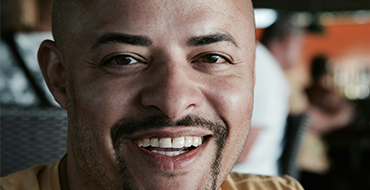What is a Crossbite? [Types, Causes and Treatment]
Have you been told that you have a crossbite smile? A crossbite occurs when your top teeth and bottom teeth do not come together properly. Normally, upper teeth should come slightly over your bottom teeth when you bite together.
A crossbite is a common type of malocclusion. A study that evaluated 1554 individuals aged 4-25 years when analyzing permanent dentition reported prevalence of 51.0% for bilateral posterior crossbite, 47.3% for unilateral crossbite on the right side of the mouth, and 53.6% for unilateral crossbite on the left side of the mouth. Unfortunately, dental crossbites can put your oral health at risk. Luckily, a dentist or dental specialist such as an orthodontist or oral maxillofacial surgeon can help correct crossbites. In this article we will explore types of dental crossbites and how to fix a crossbite.

What is a Crossbite?
What is a crossbite? A crossbite refers to an improper bite, in which the upper teeth do not correctly align with the lower teeth. Crossbites are classified based on their location and number of teeth affected. Common types of crossbites include lingual, buccal, anterior, posterior, bilateral, unilateral, single tooth, and segmental crossbites. Untreated crossbites can have a significant negative impact on your oral health and appearance of your smile. Those with crossbites are more at risk for developing cavities, gum disease, tooth enamel wear or fractures, and jaw pain.
Types of Crossbite
A crossbite is a type of malocclusion that can occur in different areas of the mouth. There are numerous different types of crossbite to become familiar with. Continue reading to discover the common types of crossbites.
Anterior Crossbite
An anterior crossbite refers to when one or more of the upper front teeth are positioned behind the lower teeth when biting together. When all of the upper front teeth are behind the lower front teeth, this is typically referred to as an underbite.
Posterior Crossbite
A posterior crossbite occurs when one or more of the upper back teeth do not align correctly with the lower back teeth. A posterior crossbite can also be classified as a lingual posterior crossbite if the upper tooth rests behind the opposing lower tooth. In addition, a posterior crossbite can be classified as a buccal posterior crossbite/scissor bite if the upper tooth rests excessively in front of the opposing lower tooth.
Single Tooth Crossbite
As mentioned, crossbites can be classified based on the number of teeth involved. A single tooth crossbite involves only one tooth. This can apply to teeth located in the front or back of the mouth.
Segmental Crossbite
A segmental crossbite impacts more than one tooth. The affected teeth may be located in the front and/or back of the mouth, and may also be additionally classified as lingual or buccal crossbites depending on the position of the upper teeth to lower teeth when biting together.
Bilateral Crossbite
A bilateral crossbite refers to when both sides of the mouth are impacted. Bilateral crossbites often are caused by a skeletally narrow upper jaw.
Unilateral Crossbite
A unilateral crossbite occurs when only one side of the mouth is affected. This can happen on the right or left side of the mouth. This may lead to facial asymmetry.
Major Causes of Crossbite
Interested in knowing what causes a crossbite? There are several potential causes, including genetic and environmental influences. If people in your family also have a crossbite, you may genetically inherit a crossbite. Genetics play a role in influencing jaw shape, tooth development, teeth crowding, and facial defects like cleft lip or palate.
Crossbites can also be caused by habits, such as pacifier and finger-sucking, tongue thrusting, and mouth breathing. Plus, crossbites can occur as a result of missing teeth, early or late loss of baby teeth, and large teeth.
Symptoms of Crossbite
- Teeth not lining up properly: If your top teeth appear to be sticking outward or inward you, or do not properly touch when you bite down, you may have a crossbite.
- Speech problems: when teeth are not in their correct places, this can cause issues speaking properly.
- Headaches: When your bite is not aligned properly, this can place strain on your jaws and lead to headaches.
- Jaw pain: Stress and strain on your jaw from teeth misalignment can trigger jaw pain.
- Tongue and cheek biting: improperly aligned teeth can result in trauma to your cheeks and tongue.
The Complications of Untreated Crossbite
Crossbite teeth can lead to several oral issues. When a crossbite is treated early, you can avoid these problems from developing. An untreated crossbite can cause asymmetrical jaw growth, jaw shifting, jaw misalignment, tooth enamel wear or fracture, facial asymmetry, jaw pain, temporomandibular joint disorders (TMD), trouble chewing, speech impediments, gum recession, loose teeth, gum disease, and dental cavities. The American Association of Orthodontics (AAO) recommends that an orthodontist evaluate children by age 7 to determine if they have oral irregularities such as crossbites.
Crossbite Treatment Options
Wondering how to fix a crossbite? There are several non-surgical and surgical crossbite treatment options. Crossbite teeth are commonly corrected using orthodontic treatment including:
- Palatal Expander: For growing children, a palatal expander is commonly used. This orthodontic appliance is placed on the upper teeth and roof of the mouth. The appliance is then periodically activated by turning the appliance’s screw with a key, which widens your palate and jaw. This treatment is best done in growing patients as the jaw and teeth are still malleable, and the palatal bone sutures are not yet fused together.
- Braces or clear aligners: Minor to moderate crossbites in children and adults may be corrected with braces or clear aligners. Braces and precise aligner therapy can help reposition teeth into their correct positions and resolve crossbites.
- Reverse pull headgear: This removable orthodontic appliance may be recommended for young, growing children with an anterior crossbite or underbite. Reverse pull headgear helps move the upper jaw forward with growth.
- Habit appliances: Patients having trouble kicking bad oral habits to the curb, like thumb or finger sucking, may benefit from orthodontic habit appliances. A fixed palatal crib can help individuals stop sucking habits by preventing fingers from reaching the roof of the mouth and upper front teeth.
- Crossbite surgery: For adults, crossbite surgery may be recommended. This is often necessary for skeletal crossbites, where the upper or lower jaws are improperly developed. This may involve surgical expander appliances or upper jaw surgery (maxillary osteotomy) in which your upper jaw is repositioned via surgical cuts. Early childhood treatment, while the jaws are still developing, can help prevent the need to have crossbite surgery as an adult.
Is There Any Other Alternatives
There are additional ways to correct crossbites other than orthodontic treatment. Other dental procedures that can correct crossbites include tooth extraction, teeth reshaping, dental crowns, bonding, and myofunctional therapy (oral and facial muscle therapy). Speak with your dental professional to determine if any of these alternatives can be used to correct your crossbite.
Crossbite Correction in Adults
Crossbite correction in adults can be more challenging than in growing children. It is easier to correct crossbites in children while facial structures and jawbones are still growing and developing, making them easier to manipulate. However, adult crossbites can still be corrected. Minor adult crossbites may be corrected with traditional orthodontic treatment like braces and clear aligners. More severe adult crossbites are often best corrected with jaw surgery or surgical expander appliances.
Long-term Benefits Of Orthodontic Treatment
Having braces for crossbite correction can be beneficial for your health and overall well-being. Orthodontic specialists obtain two to three years of additional training after dental school to become an expert in preventing, diagnosing, and managing facial, jaw, and teeth alignment irregularities and asymmetries. There are many long-term benefits of treating a crossbite, such as lowering your risk of developing tooth decay, gum disease, bone loss, enamel wear, jaw pain, and temporomandibular joint disorders (TMD). Plus, crossbite correction can improve your oral hygiene, speech, chewing efficiency and digestion, and self-esteem and confidence by giving you a straight smile.
Cost Considerations in Crossbite Treatment
The cost of crossbite treatment can vary depending on your age, location, type and severity of crossbite treatment, and your dentist’s expertise. If orthodontic treatment is chosen to correct your crossbite, the cost ranges on average between $3,000 to $7,000 without dental insurance. Many dental insurance plans offer partial coverage for orthodontic treatments, which can make out-of-pocket costs on average between $1,500 to $3,500 with insurance.
A Word from Gentle Dental
Our dentists and orthodontic specialists at Gentle Dental are experts when it comes to handling a full range of dental needs, including correcting crossbites. Crossbite before and after results are life-changing. Gentle Dental offers comprehensive dental services including orthodontic treatments for both children and adults. The earlier treatment is implemented, the less likely you are to experience costly dental problems in the future. Schedule a consultation with us today for early evaluation, diagnosis, and a personalized treatment plan.
![What is a Crossbite? [Types, Causes and Treatment]](/sites/default/files/2020-06/articles-banner.jpg)


